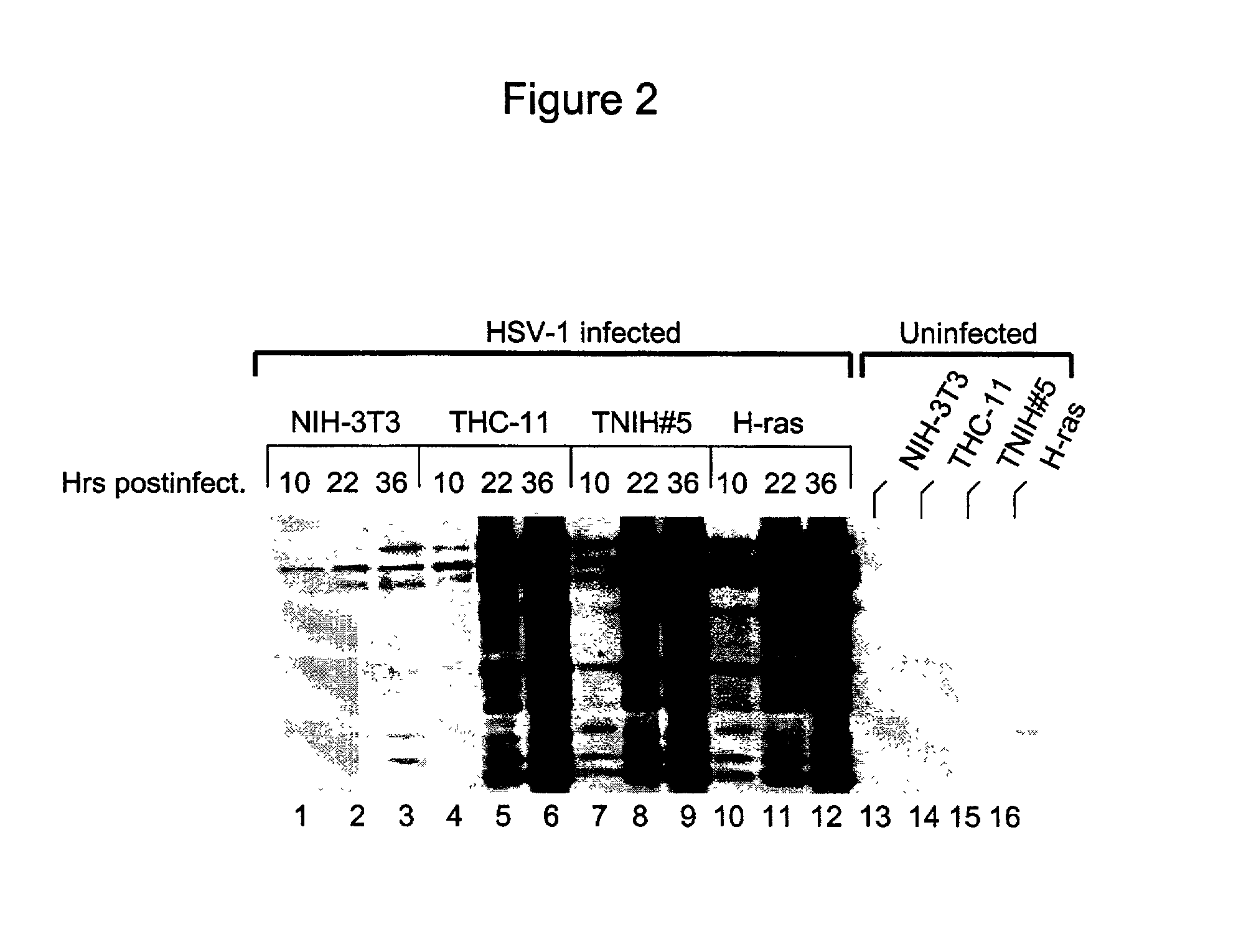Diagnosis and treatment of herpes infections
a technology for herpes and diagnosis, applied in the field of diagnosis and treatment of herpes infections, can solve the problems of lack of specificity or sensitivity, lack of reproducibility, false positives or negatives,
- Summary
- Abstract
- Description
- Claims
- Application Information
AI Technical Summary
Benefits of technology
Problems solved by technology
Method used
Image
Examples
example 1
[0087] Activators of the Ras Pathway Augment HSV-1 Infection EfficiencyNIH-3T3 cells are known to be poorly infectible with HSV-1. It was of particular interest to determine whether NIH-3T3 cells that were transformed with oncogenes which are activators of the Ras pathway were equally as non-permissive to HSV infection.
[0088] Monolayers of NIH-3T3 cells, v-erbB-(THC-11), Sos-(TNIH#5), or H-ras transformed NIH-3T3 cells were exposed to HSV-1 (strain F) at a MOI of 0.5 PFU per cell. Cells were photographed 20 hours after infection in order to determine the cytopathic effects of the virus on these cells. Cells were then fixed, processed and reacted with a FITC-labeled mouse anti-HSV-1 gC antibody. As shown in FIG. 1, little or no morphological change could be detected in NIH-3T3 cells, which exhibited a typically flattened, spread out morphology with marked contact inhibition. In contrast, cells transformed with v-erbB, Sos or H-ras exhibited rounding or clumping, which are characteris...
example 2
[0094] Ras-activated cells lines as a diagnostic tool for HSV-1 infection FIG. 3 shows that as early as 15 hours after infection with HSV-1, measurable virus titres are produced from cell lines that are transformed with activators of the Ras pathway.
[0095] FIG. 9, Panel "A" compares the sensitivity of detection of HSV-1 antibodies in three different cell lines. Cell line A549 (human lung carcinoma) is typically used in medical laboratories to diagnose HSV-1 infection. Cell line THC-11 is transformed with v-erbB, and H-ras cell lines are transformed with H-ras. All three cell lines were infected with HSV-1 at a MOI of 0.25-0.5. At 11, 13, 15, 17 or 21 hours post infection, cells were harvested and Western blot analysis was performed on these samples as described above. The results showed that at 11 hours post infection, both THC-11 and H-ras cell lines exhibited significant levels of HSV-1 protein synthesis, whereas cell line A549 did not exhibit detectable amounts of protein until 1...
example 3
[0096] The use of Farnesyl-Transferase Inhibitors to Reduce HSV-1Infection EfficiencyPost-translational farnesylation of Ras is necessary for association of Ras with the plasma membrane, and is a crucial process for the initiation of downstream events, including the three distinct MAPK cascades. It was postulated that if Ras, or downstream events initiated by Ras, is in fact involved in HSV-1 infection, then farnesyl transferase inhibitors should block HSV-1 replication in oncogene-transformed cells.
[0097] H-ras transformed NIH-3T3 cells were exposed to the farnesyl transferase inhibitors FTI-1 at a final concentration 50 .mu.M or 100 .mu.M in the culture medium. Control cells were not exposed to inhibitor. At 22 hours post-infection the cells were harvested and Western blot analysis was performed on these samples using rabbit anti-HSV-1 antibody, as described above. FIG. 4, panel "A" shows that compared to the control cells, which were not exposed to FTI-1 the production of viral p...
PUM
| Property | Measurement | Unit |
|---|---|---|
| time | aaaaa | aaaaa |
| pH | aaaaa | aaaaa |
| pH | aaaaa | aaaaa |
Abstract
Description
Claims
Application Information
 Login to View More
Login to View More - R&D
- Intellectual Property
- Life Sciences
- Materials
- Tech Scout
- Unparalleled Data Quality
- Higher Quality Content
- 60% Fewer Hallucinations
Browse by: Latest US Patents, China's latest patents, Technical Efficacy Thesaurus, Application Domain, Technology Topic, Popular Technical Reports.
© 2025 PatSnap. All rights reserved.Legal|Privacy policy|Modern Slavery Act Transparency Statement|Sitemap|About US| Contact US: help@patsnap.com



